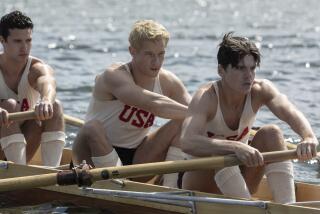Gloves Notwithstanding, Secret Is in the Stroke
- Share via
Poor little Pooh, my 16-foot Swampscott dory which I finished building about 15 years ago, still has a little way to go before my pride in her good looks is fully restored. Pooh is an example of how quickly a wooden boat can deteriorate if she isn’t given periodic maintenance.
Pooh is basically sound, but badly flaking and scarred paint and varnish gave the impression she was on the verge of becoming a derelict. A couple of recent coats of paint on her inside and varnish on her gunwales, with her hull still to be refurbished, has greatly improved her appearance.
Pooh’s neglect stemmed from the fact that my year in and out of the hospital with several abdominal (and abominable) operations left me unable to work on her, and, more importantly, to row her without pain.
Now, all is nearly well in that department and I’m able to row, not overly vigorously, but with sufficient verve to disguise the fact that I’m not quite what I used to be.
Oh, well, neither is Pooh. I guess we make a good pair, two older duffers out on the bay for some fresh air and exercise.
I rowed her around Little Island the other day without mishap. The next day I grew bolder.
“Let’s take her around Balboa Island,” I proposed to my wife. “You row half way, and I’ll row the rest.”
When we departed the Grand Canal, the wind was out of the southeast and blowing nearly astern. I let my wife row first because this would make it easier for her. She has some trouble handling Pooh’s 8 1/2-foot spruce oars. Somewhere I’d read that oars fitted properly to the pulling boat should be at least twice the boat’s beam. Pooh’s beam is a shade longer than 4 feet.
Even so, an 8 1/2-foot oar is a handful for my wife when she hasn’t warmed to the task. She tends to pull too hard on her right oar, then she has to compensate for it by pulling harder on the left. This causes her to steer a zigzag course, which I laughingly refer to as my wife’s secret method of rowing one mile and really covering two miles.
Just then, a lightweight wherry overtook and passed us. A woman wearing gloves was rowing while a man with a beard sat in the stern. The woman’s stroke was easy and rhythmic, like a metronome beating time.
My wife watched her silently for a moment, then said, “Maybe I should wear gloves.”
I agreed it might help prevent blisters, but the real secret of good rowing is an easy stroke, not dipping the oars into the water deeply nor raising them too high on the backstroke. Far too many people waste their energy raising up the oars so high they look like a windmill going across the water.
The late R.D. (Pete) Culler’s advice on how to row is among the best. He said that if you prefer to row with your hands side by side, the ends of the oars just clearing each other, then go to it.
“Most pros of the past pulled with their hands overlapping, one ahead of the other; this allows a bit easier pulling for a given length of oar, or, to look at it another way, it allows slightly longer oars for the same boat.
“It also allows you to shift things slightly to rest some muscles--you can row with your left hand aft of your right hand for a while, then use your right aft of your left. You would be surprised how well this works on a long a pull.”
Culler also says to sit straight and take a rather long pull, kicking your elbows out as you feather the oars. On your recovery, bring the blades forward again, no higher above the water than is necessary to clear the water.
On the pulling part of your stroke, lay back a little, Culler advises, but just at the end of the stroke, as you feather the oars, straighten up.
“It’s a stroke that is very nice to look at, and once you get the hang of it, it’s the very best for light-to-moderate weather work.”
In choppy water and wind, especially if headed into to it, the stroke must be shortened. The idea is to keep the boat moving steadily, if slowly, rather than have her lose headway between strokes.
Well, I try to practice what Culler preaches because it works well for me. However, I’ll have to admit that the woman wearing gloves, with the bearded man still seated in the stern, passed me by also while I was rowing around my half of the island.
Maybe the gloves really have something to do with it.
Sailing Notes
Mel Wills of Oceanside is the victor of the Holder 20 U.S. National Championship (Hobie Cats) at Newport Harbor. . . . Sunday marked the yachting season’s official ending with closing ceremonies on the Bridge Deck of the Catalina Island Yacht Club. However, several future events are on the calendar. CIYC’s Commodore John Hegardt and member Earl Spengler will host a cruise and annual meeting of the Southern California Yachting Assn. on Saturday. . . . On Sept. 14, the Southern California Cruisers Assn. will hold a predicted log race around Catalina Island. The challenge is to navigate a power vessel around the island and past check points as closely as possible to a predicted time. CIYC will host a deck BBQ for all contestants.


